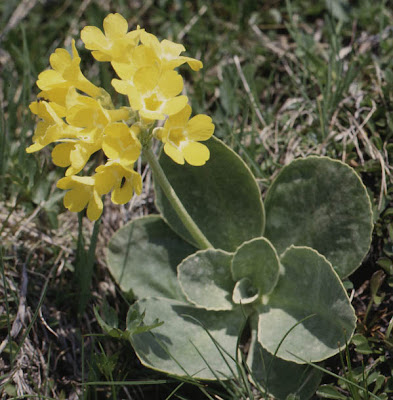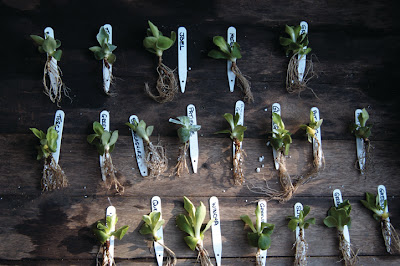
written by guest writer Karis
" ...the auricula we know today is a man-made plant. It is the work of generations of florists, using that word in its true sense of persons who cultivated decorative flowering plants, grew them to a high standard of excellence, and, as time went on, tested them by exhibiting them in competition with fellow florists..." [Brenda Hyatt - Auriculas, 1989]
.The original auricula (see above photograph), Primula auricula is a wild flower growing in alpine meadows in the mountains of N.Europe. The flowers are normally yellow. Sacheverel Sitwell in 'Old Fashioned Flowers' [1939], remarks that it does throw reds and purples as do our native Primroses, Primula vulgaris and P. veris [Cowslip] which is one explanation for the original progenitors of the huge range of colouring now available. Ruth Duthie in 'Florists' Flowers and Societies' [1988] says that the origins are more likely be natural crosses between P. auricula and the pink P. rubra, resulting in P x pubescens.
 One of the wisdoms seems to be that auriculas came to England with Huguenot weavers when they were forced to flee France in the 16th century. Sitwell thinks there may be some truth in this but notes that auriculas also continued to be bred and grown in Holland and France.
One of the wisdoms seems to be that auriculas came to England with Huguenot weavers when they were forced to flee France in the 16th century. Sitwell thinks there may be some truth in this but notes that auriculas also continued to be bred and grown in Holland and France.Ruth Duthie thinks it unlikely that the Huguenot weavers could have afforded to collect auriculas as they were much prized at the time. Auriculas were part of the general flower collecting craze but not quite reaching the same dizzying levels as that of 'Tulipomania'.
The earliest coloured illustration of an auricula is in ‘Cinque libri di pianti’ from the 1550's [Venice]. The frenchman Carolus Clusius wrote about 'bears ears' in the C16th [although more famously connected with tulips]. The plants were first recorded in print in England as 'beares eares' or 'mountain cowslips' in John Gerard's Herball of 1596. Brenda Hyatt's 'Auriculas' [1989] quotes from Gerard on the medicinal use of Auriculas "the Swiss called them 'Schwindlekraut' and used the rootes for strengthening of the head, so when they are on top of places that are high 'giddiness' and swimming of the 'braine' may not affect them"
[Please do not try this at home; I am no expert on the medicinal use or otherwise of the auricula]
.
By 1633 John Tradescant the Elder [gardener to Charles 1st] was growing them in his gardens at Lambeth and had been recorded as 'improving' them. One of Bobart's contributions to the Morisonian Herbarium at Oxford University includes pressed specimens dating to 1711.
The real explosion of popular interest in breeding and showing auriculas came in the later 18th century and continued into the 19th century. The artisans of Lancashire, Cheshire and Sheffield in particular were credited with the keenest competitions.
By the 1870's however growing and showing was in steep decline. John Hepworth who was born near Halifax in Yorkshire in 1802, started growing auriculas at age 12 and later became a well known judge. By 1870 he was so worried about the fate of auricula growing he wrote an article - ‘A Plea for Auricula Revival’ - which had such an effect that the main UK auricula societies were founded as a result. The Crystal Palace Show in London in 1877 was the first major auricula show held after the new societies were formed, over 1,000 plants were exhibited – George Lightbody was judged best in show and True Briton one of Hepworth's plants was also displayed.
Sitwell quotes from a letter to Gardening Illustrated from April 1935 from a Mr D Bamford from Middleton in Lancashire who was already looking back some 30 years or more when he wrote:
"...the show auricula was grown extensively by the old handloom silk weavers in Lancashire, a generation ago. At that time they were not troubled with the smoke and pollution that we experience to-day, and they were generally their own masters. They could, therefore, spare the time during the day to walk into their gardens and attend to their auriculas, and often to make up for lost time during the day the shuttle of the loom could be heard clicking until dusk.............I have vivid recollections [as a small boy] of their frames, sheltered under the hawthorn hedge which usually surrounded their garden.... the scent from these newly lifted frames I can never forget..."
I suppose we tend to be somewhat insular generally about our plants in Britain, Sitwell quotes from a French treatise dated 1732 which catalogues the wide range of different types of auricula available then, with names such as Le Feu Tingresse and Le Pannerok. Ruth Duthie also quotes French sources.
It would seem that in Europe the auricula specialism tended to be in alpines and in Britain the edged and striped held sway [although this was not exclusive].
.
It would seem that in Europe the auricula specialism tended to be in alpines and in Britain the edged and striped held sway [although this was not exclusive].
.
On this side of the channel names included a green edge, Rule Arbiter, True Briton - a white edge [still available in commerce], Grime's Privateer - a grey edge and Wrigley's Northern Hero, another green edge - all very swashbuckling! Also a series oddly called 'leather jackets' including George Swinford's.
How to Grow Auriculas from seedEarly February is perhaps the best time to sow pre-packed auricular seed, because there are usually a few late frosts on the horizon which can help to break seed dormancy. However if you are collecting your own seed then sowing immediately as this will usually give you a far greater seed viability and will avoid the need for breaking any dormancy.
For the best start it is wise to use a decent compost mix. Try using John Innes ‘Seed and Potting’ as a base, but add to it some horticultural grit or perlite at a ratio of 2:1, make sure that it is well mixed before use.
Stand a pot or pan of seed compost in bowl of water until it is well soaked, then gently spread the auricular seed around the surface. Sprinkle some more of the same compost on top to give the seed a thin covering. Date and label the pot or pan then place a transparent cover – such as a small piece of glass – over the top of it. Place outside into a cold, well-ventilated green house or partially opened cold frame. This will allow the seed to receive the cold temperatures whilst protecting them from becoming waterlogged.
Towards the middle of March the pots will need to be moved to a position where they are protected from strong sunlight. This can be as simple as placing them under a bench in the green house or bring them indoors and placing them in to a cool room away from direct sunlight. The transparent cover will still need to be kept in place.
 Inspect your seeds daily from this point on as you wait for germination to occur, and when a few seedlings have started to emerge the transparent cover can be partially removed to give them some air - however, seedlings must still remain protected from strong sunshine.
Inspect your seeds daily from this point on as you wait for germination to occur, and when a few seedlings have started to emerge the transparent cover can be partially removed to give them some air - however, seedlings must still remain protected from strong sunshine.Be aware that seedling growth will be very slow and once it looks like all the viable seeds have germinated, give them a very weak liquid feed in the region of ¼ normal strength. When the young plants are big enough to handle, prick them out into a good quality compost – such as John Innes ‘No 1' - and grow them on. Again, you may wish to add horticultural grit or perlite to help with drainage.
Click to see a list of auriculas kept at Kilruddery House in Ireland in 1736, taken from Heritage of Ireland Plants - and thanks to Ina.
For further articles written by Karis click onto:http://www.karisgarden.com/index.htm
For related articles click onto:
Stories, Myths, Legends and the Folklore of Hellebores
The History of Christmas
The History of the Christmas Tree
The History of Christmas
The History of the Christmas Tree
What has the Christmas cactus got to do with Christmas?
Images care of http://www.wrightmanalpines.com/blog/matt/2011-02-02/yummy-auricula-you-can-grow-them-too
Images care of http://www.wrightmanalpines.com/blog/matt/2011-02-02/yummy-auricula-you-can-grow-them-too
